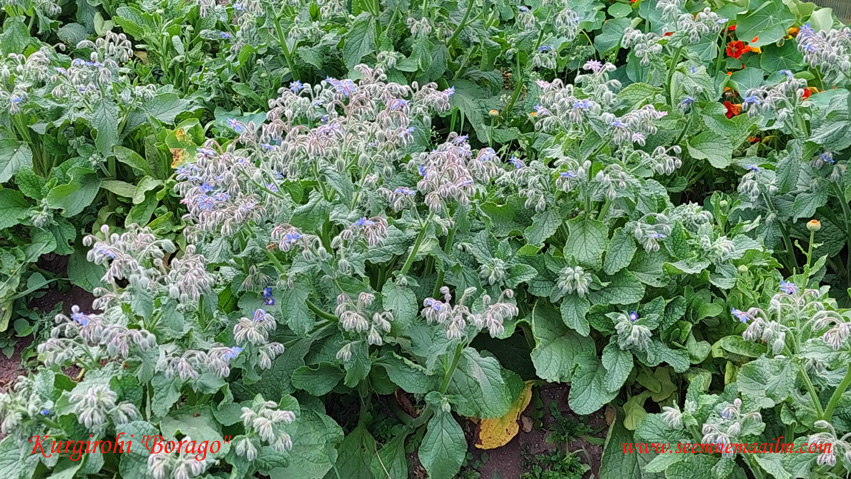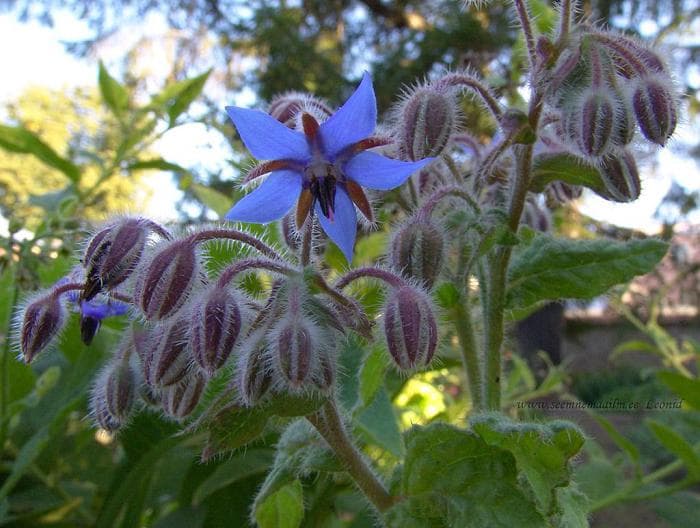Tender and juicy greens for salads with a pleasant aroma of fresh cucumber!
An annual, herbaceous and cold-resistant plant that combines vegetable and ornamental qualities: the period from germination to harvesting for greens is 38-45 days.
Plants up to 1 m high, erect, highly branched, weighing 90-100 g. Leaves are large, fleshy, with a pleasant cucumber aroma.
Green mass yield is 0.5-0.7 kg/m2.
Young shoots and leaves are used as a seasoning for vegetable dishes, canning, and pickling. They are excellent for vitamin-rich salads and stewed meat side dishes. Fresh borage juice is very beneficial for health. Dried leaves are used to make tea and in medicine. It is an excellent honey plant.
Young shoots, leaves and flowers contain a large amount of vitamins and other useful substances.
They are used fresh as early vitamin-rich greens, added to salads and various cold vegetable appetizers.
Can be eaten within four weeks after germination.
A salad, medicinal and honey plant, grown in open ground, grows well in partial shade.
To obtain young greens, sowing is carried out at several times.
Direct sowing at several times. Sow at a depth of 1.5-2 cm using a 10 x 30 cm pattern.
The seeding depth is 1.5 cm.
Seedlings appear in 10-12 days. This plant is very easy to grow. It grows best in partial shade on loose, moderately fertilized soil.
Propagated by self-seeding.
1 gram = 50 seeds.


* It looks bristly and unfriendly, but once you pick a fleshy leaf, you'll be hit with a pleasant cucumber scent...
That's why this spicy vegetable is called borage or cucumber.
A pinch of chopped leaves added to a vegetable salad imparts such a delicious aroma that the dish becomes very appealing. Borage is also used as a side dish for meat and fish dishes, adding freshness and flavor.
Borage (Burrage) - Borago officinalis.
Young shoots and leaves are used fresh and dried as a seasoning for vegetable dishes, for canning and pickling.
In folk medicine it is used for articular rheumatism, edema, and cardiac weakness.
* Borage was once considered a source of energy and fearlessness. Roman warriors in ancient times even composed a song about it: "Fortified by borage, I always walk boldly."
Perhaps the idea was that borage protected warriors from scurvy and also had a beneficial effect on digestion. Later, the Crusaders enjoyed drinks infused with borage leaves and flowers. Borage was eaten salted and candied, in condiments and botvinyas. Its flowers "were used everywhere to lighten the heart, dispel worries, and uplift the spirit." Perhaps this was meant to emphasize the joy one experiences from tasting this early, fragrant vegetable. After winter, a cucumber-scented vegetable would appear on the table. Simply marvelous!
Borage is sown in spring or fall. Choose a sunny, fairly fertile location for the vegetable.
Predecessors: cucumber, cabbage, potatoes, for which fresh manure was added.
Borage easily goes wild, which is why it grows where it was first sown. It self-sows and spreads into vegetable gardens, fallow lands, and fallow fields. With minimal care, borage will produce lush greenery and juicy, tender shoots.
To keep this vegetable edible all summer, you need to replant the crops, and in hot weather, try to plant them in shaded areas. In full sun, borage quickly produces flower stalks and becomes coarse, but only the tender leaves and young flowering shoots are edible.












